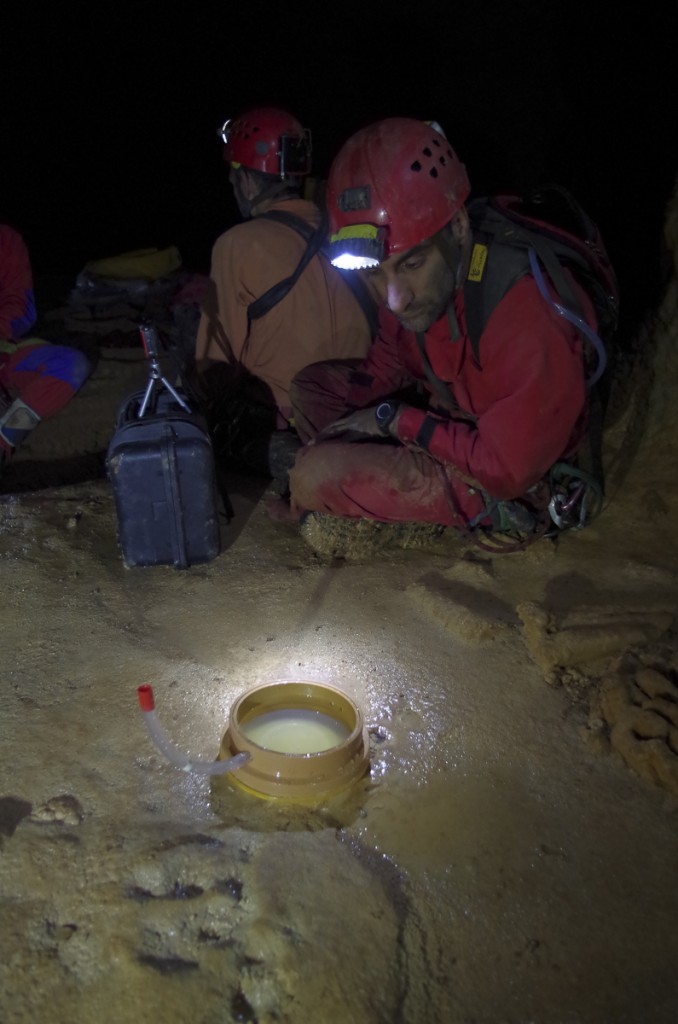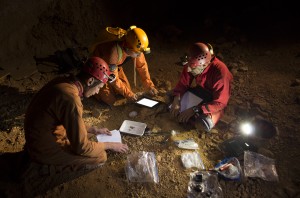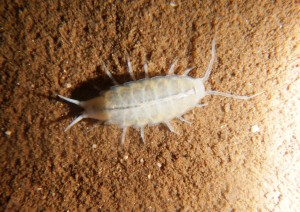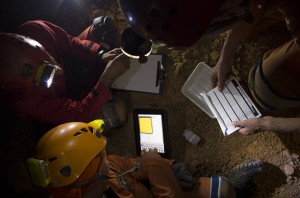
Paolo Marcia, CAVES speleobiology expert, monitors a trap for microcrustaceans.
Credits: ESA – V. Crobu
Human beings are not made for living in the dark, because we use our eyes to judge distances and adapt our movements to what we see around us. Someone who suddenly finds himself in the dark, in an alien, mysterious environment, is left apprehensive and disorientated. That is why, since time immemorial, so many legends about incredible monsters, dragons and ghosts have sprung up around natural caves. Indeed, up until 1800, people believed that caves could not possibly contain life forms.
The cave fauna in Sardinia is among the most interesting in the Mediterranean. It is very rich in species, most of which are endemic and highly specialised. This fauna has been and continues to be closely studied. Even so, more and more unexpected discoveries are made every year.

Paolo Marcia (right), principal investigator for the CAVES biological and educational science programmes, verifying an experiment procedure.
ESA-V. Crobu
Since last year, ESA’s CAVES has incorporated a substantial biological sampling programme, which studies terrestrial and aquatic fauna. This year, we have decided to focus on studying fauna deep in the ground of the caves – an environment that has not been studied closely in the Sardinian cave system and one that could yield new and exciting surprises. ESA has chosen an educational experiment that will involve all six CAVES 2013 astronauts as well many schools, hopefully from all around the world. The experiment is called Catch that bug!
In CAVES 2013, the astronauts will also study aquatic fauna inside rocks, hidden in the narrowest cracks and those that only appear in stalactites. They will use a sampling tool called a dripping filter. The fauna sampling procedures I normally use in my work have been transformed into completely different procedures that astronauts use during their space flights. That is pretty amazing!
New species
The sampling programme not only allows the six astronauts to carry out experiments, it is also designed so that they perform real scientific research that could yield surprising results. This was the case in 2012 when we discovered a new species of cave-dwelling isopod that has returned to living in water.
When people ask me why this discovery is important, I say, firstly, it is the discovery of a new endemic species, which is rare in itself. Since its discovery, this isopod has been found in very few other caves. We have added a piece to the complex puzzle of subterranean ecosystems where all organisms and the environments they inhabit are closely connected, just like links in a chain. If just one of these links disappears, the chain breaks and the ecosystem could collapse. Now we know that this species exists within the ecosystem, we will be able to protect it.
Secondly, I like to joke and put an absurd spin on things by saying, “The new species is a crustacean, and an animal that used to live in terrestrial environments and lost some of its aquatic isopods characteristics. But this particular species has gone back to living in water, and it has reacquired its aquatic characteristics. It is as if we have discovered a new species of dolphin strolling in the woods…”.
Life everywhere
On top of all this, the astronauts will see for themselves how life can develop anywhere, even in environments with no sunlight and few resources, such as caves. Caves are actually brimming with life, even though the astronauts do not notice it at first glance. There is life on the walls, under stones, in the ground beneath their feet, above their heads and in the micro fissures through which water runs, seeping out of the rocks through stalactites. One small drop of water falling from a stalactite could contain a microcosm of tiny animals: the astronauts will be practically surrounded by life. These are strange animals, though, that speleologists call ‘troglobites’. They are perfectly adapted to this weird planet – dark, damp, with no seasons and little food. They are blind and colourless, and they have bizarre shapes, unlike their terrestrial counterparts. They would be alien above ground and would not survive a minute in environments that we humans consider the most inhabitable of all.
I like to imagine that when humans reach Mars, where we know there are caves, this experience will help them to look for life there, knowing that life has few limits and could exist anywhere.
Paolo Marcia



Discussion: no comments